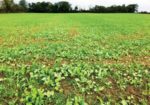Advertise Follow Us
Items Tagged with 'Ed Winkle'
ARTICLES
Your No-Till History
In time, farmers learned their ‘underground ally’ did the soil work & would become the no-tiller’s best friend.
Read More
Improving Soil Structure, Water Infiltration with No-Till and Cover Crops
Nathan Brown has benefitted from decreased soil erosion, less weed pressure and cost savings by incorporating regenerative practices on his 1,050 acre operation.
Read More
Row Cleaners: Coming Of Age
Engineering improvements and on-the-go adjustment are making it easier for no-tillers to clear residue from the row and improve seedling emergence, crop stands and yields.
Read More
Putting The Fertility Puzzle Together
Yearly soil and tissue tests, cover crops and timely fertilization to avoid ‘hidden hunger’ in plants can boost yields, says no-tiller and crop consultant Ed Winkle.
Read More
Radishes Planted With Wheat Boosting No-Till Wheat Yields
Reports of up to 18-bushel gains have pushed growers to experiment with a wheat-radish mix.
Read More
6 Surefire Strategies For High-Yielding No-Till Soybeans
Consultant Ed Winkle provides his tried-and-true tips to improve yields at key points in the growing season.
Read More










